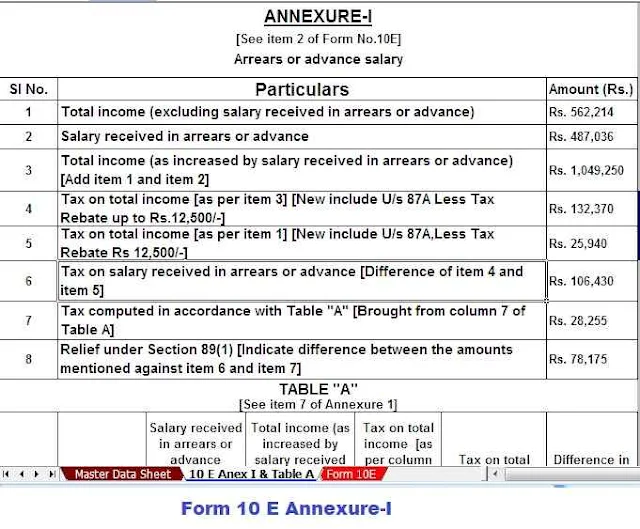Arrears Relief Calculator for the F.Y.2021-22 with Form 10 E as per Rule 21 A and U/s 89(1) In this
post, you need to find relief if arrears or payments are made in advance:
There are many instances where an employee may receive salary arrears for the current year for the correction of any leftovers of the previous year. If other arrears are added to the current year's income, the tax payable for the current year is much higher. This is due to the shift from the income tax slab rate to a higher tax slab.
Thus section 89 has been included by the government under the Income-tax Act which comes as an advantage in this context as the Act allows a tax deduction for employees who are in arrears of salary to understand other taxes.
Pursuant to Section 89 (1), the tax deduction/relief is provided by recalculation of the tax for the year in which the arrears are collected and the year in which the arrears are collected and the year in which these arrears are collected Either before. Moreover, if the designated person needs to pay more tax for the year of receipt, “if the money he was supposed to receive in the year he was supposed to receive, the additional tax may be deducted from what he actually paid. Payable. "
What is the method of calculation of tax relief in salary arrears U / S 89 (1)?
You can follow the below-given steps for mediation
Step 1: We have to calculate the tax liability on the total income, where is the salary arrears of the year received.
Step 2: Calculate tax liability on total income which does not include salary arrears for the year received. If no arrears are collected in the current year, the measure provides us with the amount of tax payable.
Step 3: Calculates the difference between tax liability as step 1 and step 2. It will be taxed on the extra salary associated with the total income.
Step 4: Calculates the tax liability on the total amount of arrears received for the arrears concerned.
Step 5: Calculate the tax liability on total income which does not include the amount due for receipt of arrears.
Step 6: Calculate the difference between the calculation amount according to step 4 and step 5. This gives us the original tax liability of the previous year which is due for the current year.
• Step:: Exemption of additional amount of tax in the amount of step at under section 89 which is allowed under the Act. In this case, there is no additional that if the tax calculated under step 3 is less than in the calculation of step 6, relief is not required for the employee under section 89 as no relief is allowed.
You can go to the income tax website for calculating relief under section 89, there is a link- https://www.incometaxindia.gov.in/Pages/tools/relief-under-section-89.aspx
Which section applies to section 89?
Relief is available under section 89 (1) in the following cases:
Salary arrears or advance available [Rule 21A (2)]
Gratuity received for previous service [Rule 21A (3)]
Compensation after the termination of employment [Rule 21A (4)]
Payment of pension conversion [Rule 21A (5)];
Procedure for claiming tax relief under section 89
To get relief under the paragraph, 89 people have to "submit Form 10E available for Income Tax Portal within the new e-filing portal, log in and go to Dashboard, e-File> Income Tax Form> File Income Tax Form). Submit Form 10E. “Just essential. In case of non-submission of Form 10E, ITR will be processed but relief sought under 89 will not be allowed which will be allowed only if it is dependent under Income Tax Act 89 if the 10E form is available equipped before ITR.
Let us know the calculation with the help of examples though
|
Sl No. |
Particulars |
Amount |
|
1 |
“Tax payable on
the total income for FY 2020-21, including the arrears” |
1,54,440 |
|
2 |
“Tax payable on
the total income for FY 2020-21, excluding the arrears” |
1,10,760 |
|
3 |
“Difference
between Step 1, Step 2” |
43,680 |
|
4 |
“Tax payable on
the total income for FY 2019-20, including the arrears” |
1,06,600 |
|
5 |
“Tax payable on
the total income for FY 2019-20, excluding the arrears” |
75,400 |
|
6 |
“Difference
between Step 3, Step 4 |
31,200 |
|
7 |
“Amount of
relief = Step 3 – Step 6 |
12,480″ |
Let us know that Mr Arun has received Rs. Under normal circumstances, he has paid "Rs. 1,10,70 tax on his income of Rs. 9,70,000 / - for the financial year 2020-21". But, after adding the arrears of Rs 1.5 lakh, his tax liability increased to Rs. 1,54,440.
Moreover, towards the financial year 2019-20, he paid Rs 5,400,000 tax on his income, which was lakhs of rupees. Did he get arrears of Rs 1.5 lakh that the tax liability would be Rs 1,06,600 as they have arrears for the year?
This information calculates the tax relief available to Mr Arun:
Note: If the tax payable under step 3 (arranged in the year of receipt) is less than the tax payable under step 6, it indicates that no relief is given if there is no additional tax.





